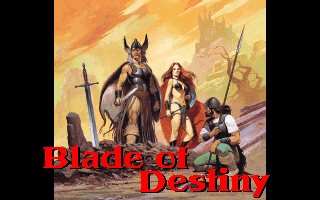
After I write that review about Undernauts, there were two ideas which I had in mind, one was a blog about Cyberpunk 2077 and the other was Elden Ring, while the text of the first is already a pretty huge draft, between Edgerunners and the text itself become less about the game and more me rambling about different types of open world games, I decided to postpone as I might need to rethink some parts.
The Elden Ring, which is a clearly one of my GOTY, the text itself exist only in the realm of ideas so far.
So how I end up writing about Realms of Arkania? I played this a long time ago and finished it, but lost the save. Since the Realm of Arkania is a trilogy of old school crpgs, the kind where you can take your save to the next game, it meant I had to replay if I ever want to tackle the other two games.
And that is what I decided, let’s do it again, and turn out there was a lot of things I did not remember to a point that the revisit proved to be really worth. Also while looking in the game file, in the gog version, the first two games come with a cluebook, which was fascinating reading, while you might expect it to just be a walkthrough, it features a lot more, from some interviews and even commentary of the beta testers as they give some hints, this was a very curious peak behind the curtains that help me make my mind.
To make a point very clear, while I find some old school rpgs fascinating, as some might remember my post about Might and Magic, I am not over nostalgic or anything, per example, while I enjoy dungeon crawlers, my favorites ones lately tend to be the Wizardry successors, which came (and still coming) much later.
Now while sometimes is tempting to think that there is only one “right” type of crpg, to where everything should converge, I prefer to think in different types crpgs (or sub-genres) with different emphasis, that sometimes run side by side, or they can converge or diverge ways (sometimes very subtle ways), like vines. I say this because it is easy to hyper fixate in a handful of (or one) game (in the either past or present) and disregard the entire genre past and future (and sometimes anything which isn’t a wcrpg).
To make it very clear, I don’t thing Realms of Arkania or the setting is some kind of work of genius without faults, but I do finding it fascinating with a lot of things, for good and bad, that it made stand out.
So, this blog is going to be the first part of three, covering the Realms of Arkania trilogy, the “Northlands Trilogy”, I will cover the original games, released in 92/93 (Blade of Destiny), 94 (Star Trail) and 96/97 (Shadow of Riva) and developed by Attic. Now I guess a lot of readers might already read about the series from Hardcore Gamer 101 articles about it, I will try to not repeat points, so I recommend also checking that out.
Now, I won’t talk the remake (developed by Crafty Studios and published by United Independent Entertainment), because despite the low metacritic score, the myriad of bugs and issues, I confess not begin much a fan of cheap shots and from what I could understand, the developers did what they could (there were several patches), but a game like this is trick to remake or remaster, because, for reasons which I cover in this blog, this a deceptively simple looking game, but unfold itself in rather complex ways, like requiring way more resources and time that they could have. Also, I not feel like buying the said games.
Ok, so let’s set up some stuff we need:
- This first post will like be longer, since I will give not just a general description of the game, but also it ruleset and some minor details, in later parts I will cover what changed between games.
- I will not give a whole walkthrough, just some key points, but I will try to give some hints about the skills for reasons which make sense as I describe the game, that might help you if you wish to check out yourself. By the way, I do recommend check both the character creation guide by bebopcolagood before creating a party and the walkthrough by Lord Marcus Dragon on Game Faq if you got stuck.
- In the end, I will put two things: one is a popular fix for a bug during party conversion from Blade of Destiny to Star Trail that cause the infamous “kid face bug” and how it was for me, because I think that there is an extra step. Second, I will comment a bit about remake/remaster, but not the games which I talked about, but rather if it would be possible.
What is Realms of Arkania?
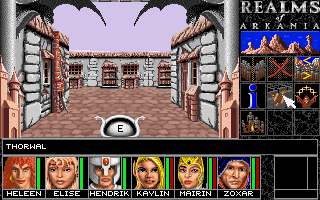
Now it is easy to think of trilogies as something new, but this isn’t the truth, Arkania, much like other games from the period, such as Ultima, Eye of the Beholder, Ishar, Might and Magic, Pools of Radiance, and others, where in fact (often planned ahead) trilogies that you can even transfer your save from game to the next.
Like I said above, the “Northland Trilogy” is composed of three games: Blade of Destiny, Star Trail and Shadow of Riva. Now each one is a sort self-contained story with points of direct connection.
In the first game, an orc army is approaching the town of Torwal, and its Hetman comes up with a plan: send adventurers to find you the fabled sword of Hyggelik and with the sword in hand challenge the Orc leader, avoiding the war.
In Star Trail, the player is both looking for the Star Trail and Salamander Stone, while dealing with the fact that the Orc army might have stopped in Thorwal, but in reality it just changes direction. The last part, Shadow over Riva, is sort entire focused on Riva which is besieged by Orcs where the player must investigate a mystery which is unfolding in the town.
One aspect which make Realms of Arkania fascinating, is that due begin a rather direct translation of The Dark Eye (Das Schwarze Auge in the original), one of the most famous tabletop rpgs in Germany (note: Attic, the developers, were also from Germany, it was Sir-Tech which would distributed the game) make the game a sort time capsule. From what I could research, the game uses the third edition, from 1993 (the original Dark Eye was from 1984).
Q: What can players look foward to Star Trail (the second game in the Realms of Arkania Trilogy)?
A: Sometimes will remain the same and other will change, as for example the title, Star Trail. We are trying to put the emphasis on Star Trail more on playability and enjoyment of the game that the basic system. Since now we have a “ROA-compatible” engine we can spend most of our development time, improving things…
(Realms of Arkania 1 Cluebook, page 21).
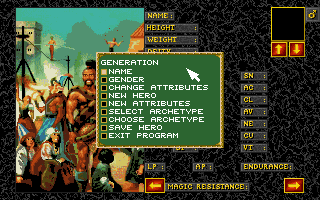
I don’t have access to the actual rule set they used, but I can glimpse a general idea, now while due begin AD&D contemporary, it can be tempting to see it as “heartbreaker”, a term often used to describe rpg systems, which are sort like AD&D but often with one or more good ideas buried in bad ones. I don’t feel this description fit for the case, but keep in mind I don’t have the actual ruleset itself, and what I can see, appear most of the time to work well.
Now, again, keep in mind, my only source is the game itself and some research I made, so I can only give you a general idea, but that should be enough.
There is something which I read a long time ago, maybe in a rpg forum or even back in a mailing list, I don’t remember the exact words, but it was something about how some old tabletop rpgs, had much of the heavy work character customization was done during creating a character. Even it wasn’t s unusual, depending on the system, to take a whole playing season, or more. But once done, your character often follows a linear patch, maybe with some small adjustment along the way, but that is it.
Realms of Arkania is kind like that, which is strange for today, but there is a certain charm of spending a good time, carefully crafting your party (at least in the game, I can’t tell on the tabletop), since it can take a while… so much that the generator is sort appear of the game itself (you can even print the said character). But, there is a key difference: you can customize your characters a lot more during level ups, which make the game feel different, in comparison to other games of the period.
So, what is main features of the rule set? First, it uses a set of seven positive attributes (Courage, Wisdom, Charisma, Agility, Dexterity, Strength and Intuition) and seven negative attributes (Superstition, Acrophobia, Claustrophobia, Avarice, Necrophobia, Curiosity and Violent Temper), also its equivalent of what in other systems might be called classes, here (at least in Realm of Arkania) are called Archetypes, which fill the expected roles, but funny enough, non-humans and some humans (again, at least in Realms of Arkania), have their own Archetypes kind like in old D&D Elf was a class, in the game we do have the Thorwalian, which I will describe later, but it is a sort of fantasy viking.
Another difference is the usage of tons of skills, which AD&D did also, but here they are plentiful, in fact each Archetype have it own huge selection of skills, meaning they can be customized a lot more than one could expect in the time period. Spells, from what I could understand, work much like the same, meaning that certain Archetypes have their own selections.
From what I could get, Archetypes, more that give you access, they give you a positive modifier on certain skills and a negative on others, which would be your “class” skills. Now what I find curious, is that in theory, I think you can teach a character in a skill outside the Archetype selection, as long you can spend points reducing the penalty, however, this isn’t something simple, but it is doable.
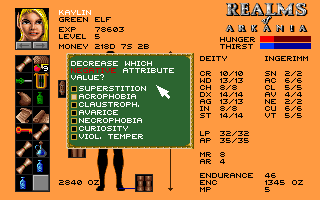
When your character level up, you can increase one positive attribute, while have the chance of decreasing a negative one, also you gain points to spend in both skills and spells. Again here, when you spend a point, instead of certain improvement, it is a chance (yeah it is strange that you can fail), and you can try up to maybe three times during each level up, and only improve some skills twice in the same level up.
Now with a good context of the system and its origins, shall we dive on the Archetypes featured in the game? Because it is a huge feature of the game, and once done we shall move to talk about the skills and spells.
Oh, there is one thing, which I almost forget, the game does feature two modes: Advanced, which is the one I used, and Novice, which let´s the game decided a lot of the minor details.
Archetypes:
So, let’s go one by one, as I told, this is a long dive, now before we start, something which I forget to add, as you can imagine, each Archetype does have it own minimum requisite stats (both the positive and negative ones), which sometimes make some of the Archetypes feel like a Druid or Paladin in AD&D in terms of high requirements.
Sometimes, Archetypes appear to suffer from constant overlapping of functions and roles, this isn’t an issue on tabletop, but in the game, can generate character with very vague roles.
Jester: With focus on Point and Thrown weapons, and its skills are focused on Body, Social and Craftsmanship, making them I think some sort of fighter/thief, but there are better choices.
Hunter: Kind like the name suggest, they are sort a ranger style of archetype, focused on Missile Weapon and the Body, Nature and Intuition skills, but overall Elves are better.
Warrior: Not much to say here, this was one of the classes in my party, their only drawback is the limited skills in other areas.
Rogues: The actual thieves, better that Jesters, they also got access to Intuition skills and their Pickpocket and Lockpicking make them very useful, this was another class pick I made.
Thorwalian: They are sort of a budget warrior with some Nature skills and focus on Axes, nothing exceptional, but I also picked this class for the party. In case you wonder what a Thorwalian is, they are sort the Nordic people of the humans of the setting. For some reason, their minimum stats require Superstition at least of 7, which make them sort weak to magic, as this negative stat affect that area.
Dwarf: Now things get curious, as you might expect, this is a fighting class, and it is, but with a twist, Dwarfs are good with Lockpicking… which make them quite useful and even a potential rogue replacement, In my first play of the game I did pick a dwarf, so for this one I decided to skip.
Witch/Warlock: As we approach the magic classes, thing get complicated, as the actual spell selection is pretty strange and often make it hard, unless constant check of the manual, to figure what exactly the role is, to be fair I have no idea Witch are meant to do.

Druid: Again, spell selection is a bit strange, they got some useful spells, but lack others, like healing, even if they have very good bonus for healing skills, I did pick this class, but find myself simple leaving the druid still during combats until I remember they can use bows, in the first game, in the second they no longer can. Also, is pretty weird they can’t use sickles, which was a huge let-down when I find a magical one.
Magician: Not much to talk here, is pretty good class, I also picked this one. They can choose a main magic school as their main expertise.
Green/Silvan/Ice Elves: Those are sort of the same archetype, with some differences, different spell selection and weapon/armor restriction, but they are pretty good, in my play through, I picked up Green elf, which was a key character, because the way missile weapons work (they appear to miss way less that all other weapons), plus their Nature skills and magic made the character pretty good.
Skills and Spells:

Skills and Spells are spread in groups, I shall cover them a bit, because this again, appear to be taken word by word from the tabletop, however not all is used or maybe even implemented, meaning you can have stuff begin both vital and useless. To make things complicated, remember, this is a trilogy of games, in general most skills remain useful the whole time, but certain skills can become vital in certain games but not in others. To make this blog post a bit more useful, I shall also mention the skills which I remember most using.
Also, some skills can be only used (or are checked) if the person with the skill is the party leader, thankfully change the party leader is really easy.
Combat:Unarmed, Cutting, Point, Swords, Two-Handed Swords, Polearm, Axe, Missile, Throwing.
With a subtitle of “Blade of Destiny” you can imagine that swords are quite important, in fact many of the magic weapons you will find are one-handed swords. But moving from this, things get strange, Cutting, despite it name, also include maces. Meanwhile, I never used unarmed and Polearms. It is pretty strange to have Sword splint in two categories, because if am not wrong, even some two-handed axes might count as the Two-Handed Sword for the skill.
Keep in mind, each weapon skill, have an attack and parry value, meaning that when you increase a weapon skill you also rise (by choice) either the attack or parry values.
Now missile is very important, like I said above, each weapon skill have a Attack and Parry value, except bows, meaning enemy can’t parry, and it will hit more often. Throw is similar, but outside of infinite magical throwing dagger you can get later, they aren’t very useful.
Body:Climb, Acrobatics, Physical Control, Ride, Stealth, Swim, Self Control, Dance, Hide, Carouse.
Ok, of this Climb, Swim, Physical Control and Self Control are the most important and often the most used, Ride, from what I read about is only used in the second game, while Dance and Carouse can get some coins in tavern.
Social:Convert, Seduce, Haggle, Streetwise, Lie, Human Nature, Evaluate.
No Seduce isn’t used at all, Convert appear the same, as Lie and Human Nature, maybe Evaluate too. However, Haggle is useful, but only very early on, because later money won’t be a problem, Streetwise maybe avoid some random events in towns, but I never noticed.
Nature:Bind, Track, Orientation, Herb Lore, Animal Lore, Survival.
Surprise, almost all of them are quite useful. Herb Lore is pretty useful, but not very reliable, to find special ingredient, which you can make in potions, but is a kind of long process, which I never used, however some ingredients can heal a character, acting as a cheap healing potion and sparing magic user Astral Points.
Lore:Alchemy, Ancient Tongues, Geography, History, Ritual, Tactics, Read/Write, Arcane Lore, Tongues.
Yeah, you can use Alchemy to make potions, if you have the ingredients and maybe the recipe too, but I never used, Arcane Lore is very useful, to increase spell potency, the rest have a use or two. Save this, I think there is at least a key moment, where Read/Write (and maybe or Tongues or Ancient Tongues) is used.
Craftsmanship:Treat Wounds, Poison, Disease, Instrument, Locks, Pickpocket, Cheat, Drive, Animal Training.
The triad of treating wounds, poison and disease is pretty important, so make sure some character have them. Locks are important too, you can bash some doors (but I am not sure of chests), so make sure to have a Dwarf or Rogue with some Lockpicking. Instrument and Pickpocket are used in taverns and shops to gain extra coins, while Drive and Animal Training is never used.
Intuition: Danger Sense, Perception.
Both are very important, one avoid traps while the other detect secrets. The first is important for character in guard duty during rest and the second is key when dungeon crawling to detect secret doors (even if you know already, by look in a guide, only until a character succeed in detecting them you be able to use them).
Spells
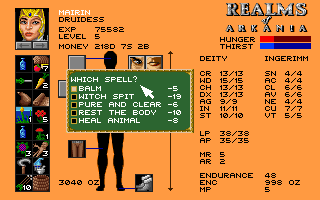
The main problem, is that many of them use non-descriptive names, and since there is no tooltip, you often have no idea what all spells do, I won’t go spell by spell, it would take forever, but you can expect, like in skills finding a handful of they are quite important and the others useless or maybe exist in game, but don’t work at all, it is hard to tell. Now the main thing is that spells, like skills have a chance to fail and this, at least in the game, can make them feel unreliable most of the time, specially in combat, but later on, as you point more points in them thing become better.
Dispel: Can’t comment much about it, of my three magic users, a Magician, Green Elf and a Druidess, only had access to the Break Domination spell and maybe one or two more, which I never used.
Healing: Balm is the only spell which I used, and often was the Green Elf which cast it, since the other two don’t had much access to this.
Domination: Ok, at least here the Druidess had is moment on the spotlight, the Evil Eye spell, is pretty useful to turn enemies in to allies.
Demonology: Never used a single spell, the Druidess had access to Banish Spirits and Conjure Spirits, but I forget using them at all.
Elemental: Never used a spell, I don’t think any of my character had actual acess to them, maybe the Green Elf…
Movement: Foreman is a spell which open a locked door and chest, which both the Magician and Green Elf used a handful of times.
Clairvoyance: Of this, I mostly used Odem Arcanum, which tells if an item is magical or not and Analyze Magic, which tell a magical item actual proprieties.
Illusion: Never used a single spell.
Combat: Only used four, mostly because of the weird spell names, which make it easy to forget what each spell does, but Iron Rust is pretty good (as it remove the enemy weapon), Lightning leaves an enemy blind, Fulminictus is a direct attack spell, which is pretty good too. Ignifaxus is a sort of direct attack spell, which you can set the potency, by spending more Astral Points.
Transformation: This is mostly a school based in buffs, but from what I heard Ocean’s Floor and Visibili, which have no use at all in Blade of Destiny but are pretty useful in the next game.
Transmutation: Fiax Lux, a spell, which as the name implies, generates light is pretty handy, the rest? Not so much.
Last Details
Ok, with this all covered, let’s finish the details: Each character will have a random faith, which give some minor bonus, also you get random height and weight, which often generate weird results, I got really huge characters, but there is no effect. The portrait selection is pretty limited in the first game and the quality isn’t very good, however, in the next one they good slightly better.
World Design
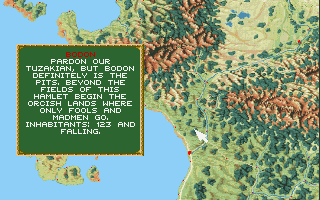
Another aspect which is fascinating about Realms of Arkania: Blades of Destiny, is that somehow, the game is quite large and small at the same time:
In total, you have 16 dungeons and 52 towns, remember when I said this game, and many old crpgs, could look deceptively small on the surface, but rather huge once unfold? Part is because is simple visual nature, allow this, that is why I think that remake or remaster those game can be very hard.
In the next games, Star Trail and later Shadows of Riva, the world design would be reduced, but for now, this huge size is what we have, and what the game is.
While the world itself is pretty huge, the amount of places you need to go in the main quest isn’t that large, in fact, save a handful of towns, you might need only to explore up to maybe three to four dungeons at best.
Again, this feel like the ambition was to bring a tabletop setting alive in the game, in the game to the minimum details. So you end with this sort of world design, where the world itself exist for it own sake rather that the players. Several places, specially the towns, can go from rather huge, such as Phex, Thorwal, while others can be tiny. But each one might have or not different shops, temples, inns and so on. Sometimes, a town you came across, simple exist, in both description (and each town does have it own description and even a general population number) and function, as mid-point between two other places, others might be a literal back end village.

Travelling is a large part of the game: Instead of just clicking on a point in the map, the way you do is that each town and dungeon, might feature one or more exit points, each one might lead to another town. Beside these, some towns feature ports, that have their own routes and schedules, leading to other port towns. This all means that planning the actual route will need is important thing you do in the game, that sometimes is pretty straightforward as the over world map show all connection, except in two cases, some places might have routes which does not show in the map and then there are the mentioned ships and their routes, which at best you can ask, but is hard to know, which port lead to where and when ships arrive. Even the seasons might play a role, as certain routes can get closed during certain seasons.
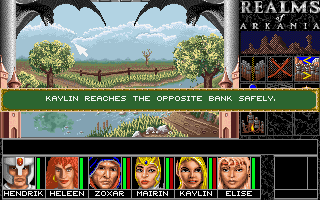
More than this, is when you are travelling is that the game sort become a bit of survival game, many of your party skills, might play a role, during rest moments, party members can hunt or look for water, collect herbs, treat wounds, poison and disease, also party members must be assigned to guard duty, where perception and danger sense is used. Even during the travel itself and in the events which can happen, skills do play a role. Not to forget, you need to have rations, water and maybe blankets too, rope can be useful in some events.
Now dungeons themselves are often hidden in between two towns (but some might be reached from multiple directions), to find them either you might come across some events, hear rumors in taverns or a npc might point you where it is. One cleaver trick, is that when you exit a dungeon, your party will instantly reach is destination, so if travelling from A to B, there is a dungeon, you enter and leave, you instantly reach B. This is quite handy, because, between spend resources, weight of all stuff you pick up, while have to deal with the travel itself could be too much.
There are some annoying parts during the travelling moments, as there are some parts of terrain, specially swamps, which there are chances to lose items you have. You can avoid it most of the time, save one or two exception.
Now when visiting a town or dungeon, the game perspective changes to a first person grid base of dungeon crawl, however, most dungeons and towns are quite small, I don’t have the exact size of the maps (they don’t appear to follow any standard size), some towns, like Thorwal, Phexcar are quite big, but others can be tiny, dungeons in general medium size, save some earlier dungeons, like the Imperial Fortress, which have five levels, mostly have a single, at best two levels and each one is not that large.
So what, to return a point above, the world exists for it own sake, rather that the player, as a translation, in literal way, of the setting, where many dungeons and places exist as potential rest stop or adventures, which you might even miss.


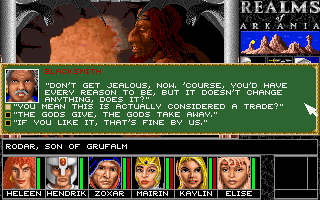
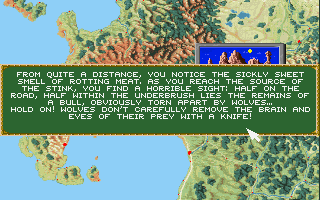

Dungeons
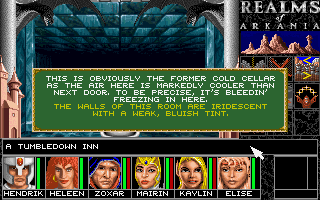
The game does have its fair share of dungeons, but like I said above, only a handful are must see places due to the main quest, the rest however can be a pretty worth delving in to, as some of the few magic items are there. But the problem is that finding them is quite trick, some are simple, like I said, between two points, but to access some of them, you need to be aware of it, either by a npc, quest or rumor. But at least two towns feature a dungeon, that is simple there, in Thorwal, there is the Imperial Fortress, which is the game tutorial dungeon and then is another town there is an abandoned Dwarf Fortress.
Also, the actual size is often small, and each floor, likely like have a few key or interest points. When came to puzzles or traps, things get trick, on the puzzle aspect, there is a handful which require splitting the party, such as leaving on character behind holding a lever, or a mirror based puzzle, which require splitting the whole party to do something which I confess have not truly understood, but still manage to do. However, there is at least one well known bug, where setting spider eggs on fire in the Spider Cave causes all dungeons to become toxic and in a later puzzle in Hyggelik tomb, if you do things out of order, you can maybe softlock yourself.
Notable Spots:
Note this section only contains a handful of places, the game does feature more.
Imperial Fortress:This is the game tutorial dungeon, is pretty huge, with five level, but only three are truly required, for the side quest, but the other two levels feature a hard fight and some treasures.
Tumbleweed Inn:Between Daspota and Ottarje, you might come across an abandoned Inn, if your party tries to rest there, they will notice something is off and find out this dungeon.
Daspota Treasure: Between one route of the three towns from which you can reach Daspota you might come across an event which point you to this dungeon where pirates have hid lots of treasures.
Daspota: It is not a dungeon, but rather a town… filled with pirates, in sort each house can become an encounter and some spots feature rather good treasures.
Dragon Hoard: The reason you might go to Runin, as the name implies, there is a dragon there, but while you can fight it, you can also do a quick quest for him and got the treasure.
One worth detail is that the cave is between Runin and Runin´s Lighthouse, but… ok there are actually three exit points in Runin, while each one leads to the Lighthouse, but only one is where the cave can be found…
Ghost Ship:I was only aware because of the cluebook, I have no idea how you meant to know this place or how to find it, maybe is travelling via ship? I don’t know, during my playthrough I did use ships a lot, but I mostly got attacked by pirates and one event about maybe a Kraken.
Later I was reading again the clue book, and there, the developers say you should go to the “Four Winds” Tavern in Thorwal… where you can hear the rumor about, but there are tons of tavern in each town, making quite hard to find out.
Dark Mage Tower: As a part of the quest for the Hyggelik tomb, one of the pieces end in the hands of mage which is hidden in a dungeon, but is a bit complicated to reach depending on where you are, as the path can be closed during winter.
Also, it features a rather obscure puzzle, by defeating some orcs you get a powder, which you have to use to unlock a secret passage, but how exactly you are meant to figure out this on your own, down to the exact spot, eludes me.
Orc Cave: A key item is there, but is in a point between too faraway towns, making the travel really annoying, as if feature a spot you can lose items.




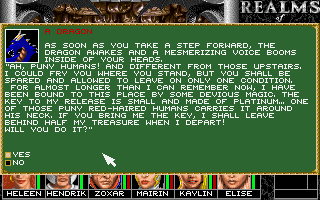
Combat:
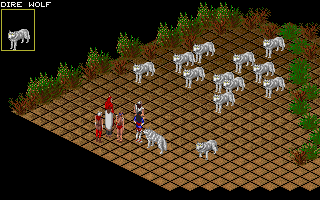
The combat is pretty simple, your characters and enemies move in accord of their initiative (I think), have a movement points, which they used to either attack, cast spells and other stuff, with each action have different costs. Now those movement points are affected by encumbrance, so if you are carrying a lot of stuff, you can end with a character unable to even attack or move at all.
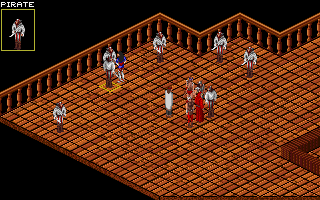
When attacking, and here I can only speculate, as I don’t have the actual rules, the game checks for Attack Values and them, again, emphasis on the word, I think, it does two checks, first if you succeeded or not and if yes, then it checks the enemy Parry Values. Oh, by the way, you can choose between three types of attack, I am not sure on what each one does, I think one increase damage, another increase chance to hit, and the last is a normal attack. Also, weapon and armor can have penalty or bonus to Attack and Parry values.
This result in early game feeling a bit slow, as character (and enemies) often miss or got attacks parried a lot, add to this the fumbles and even potential weapon breaks. Oh, yes, weapons can break, it is rare but happens.
Like I said above, parries also cause Missile Weapons to become very powerful, as they will often hit more than all other attacks, since the enemy can’t parry them. Except that in Blades of Destiny you can only aim in a straight line, which make position and reposition very important (in later games this was solved, as the character can aim diagonally).
But continuing, I noticed that this often results also in combats ending with enemies fleeing when they lose enough hit points, thankfully, they still drop items when the combat end, meaning you won’t risk missing a key item because the enemy run away.
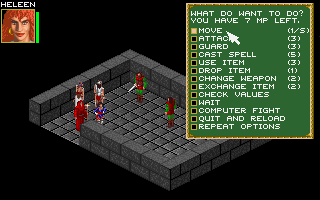
Now one problem the combat have is the lack of feedback, as there is no combat log, so it is hard to tell why something did happen or not, that is why I am not sure how many checks happen during an attack, a character might simple misses, but is because failed the skills or the attack check? This can sometimes generate an issue, where you are not certain if you are missing because your characters are too low level, or they are simply unlucky or even the enemy require magic weapons (or not). I had a moment, early in the game, where my character faced a demon, I keep missing attacks unsure of what was going on, eventually I made it, thanks to Missile Weapons and spells, but until there I had little idea on what was going on.
Since we are talking about combat, let’s move to encounter, enemy balance and other stuff. Now the major surprise, depending on own vision of old crpgs, is that encounters in this game are pretty rare, while if feature both random and fixed, they are both pretty rare. Which can make some dungeons feel a bit empty here and there.
On the enemy variety, it is overall fine, you mostly like face humans (in form of brigands, mages, pirates, cultists and so on), orcs and goblins and some animals, there are some rare enemies, such as ogres, skeletons, harpies and a few more, plus some unique enemies. Isn’t much, but it will work with the pace of encounters the game have.
One thing, which might be an issue, but was more a limitation of the period, is that sprites for enemies are pretty limited, meaning it is kind of hard to tell them apart from unique enemies and sometimes, enemies share the same sprite as your characters. And yes, you can sort friend fire your own characters.

On the balance aspect, most encounters appear doable, with no major issues, even unique enemies often do not have that much hit points, spell casters might cause a problem here or there, as some might cast spells such as Iron Rust (which can ruin a character weapon), but that is it. Now when thing can get trick is numbers, while sometimes a random encounter might simply spawn one or two enemies, which isn’t a problem, in fixed encounters you can be in a spot, where there could be a ton of enemies, which can overwhelm your party, but the main risk most of the time is everyone missing attacks.
Rewards:
We talked about combat and enemy balance, how about the rewards? How it fit in something which I explored, but in another contest, in case for a certain type of dungeon crawler games? First, let’s look at what itemization the game does offer:
It is very curious, in one hand, there are only a handful of magical items, which unless you read the cluebook, or keep casting Odeum Arcanum and Analize spell over and over again, is pretty easy to miss.

But in the other hand, due to the game begin, this translation of the rulebook and setting, and if you remember old books, they often come with huge list of equipment, you won’t be surprised that there is a ton of stuff in the game, from weapons to armor, to a endless list of stuff which you can buy but will never use, at least in Blade of Destiny. Which can be a bit frustrating, as you can be unsure of what you need and what is just useless. Like, Waterskins, Rope, Alchemy Sets, Rations, Lockpicks are useful, but there is other stuff such as Nets, Quills and so, which you never use.
As I said above, in Blade of Destiny, while your character might look at an item, it won’t give the actual stats (this however is fixed in Star Trail, where looking at an item does show it stats), which make tell the difference between the tons of weapons a bit hard without the manual.
The way you find treasure or loot is three ways, one is by defeating enemies, which at the end of combat might give you ducats, weapons and armor and key items. Another is chests, which mostly have fixed loot and third, some places, like houses, can have treasure too, which is also fixed.
But when it comes to actual rewards, most you will find are ducats, like a ton of them, to the point you will don’t need to use some skills, but will often have not much to buy too. Near the end of the game, each of my characters had around 300 ducats, which in the setting is a lot.
Past this, and sometimes weapons and armor and the rare magical item (which will find in fixed places and encounters), the game loves to give you a ton of some random stuff, most time, Rations, but Brandy and Beer show up often too, remember all of this have weight.

Well, since I mention, I might well talk about it, as I said above, character have a weight limit on stuff they can carry, which cause them to lose Movement Points in combat. Early on, dealing with this is a bit trick, depending on the character actual Strength, because the total weight, isn’t just stuff the character have equipped, but stuff which they are carrying, and you need often a lot of stuff, from a spare weapon, potions, blanket, rations, extra arrows/bolts, quest items, rope and something to drink. This has the side effect of masking you not much changing gear early on, even if you have the resources due to the weight. Now later as you gain levels, and maybe spend a point or two in strength, it does get better.
Oddities and Ends:
- Now while the game does feature a sort of paper doll style of inventory, similar to games like Eye of the Beholder, in Blade of Destiny is pretty strange, as you don’t have many slots for equipping stuff as you might imagine. There are no slots for rings or necklaces or belt, per example, instead those are equipped in character hands. Later games would fix this. But a little cute detail, is that when you equip certain magical items, the game does show up a small animation.
- While there is an option to add a seventh character to your party, it does feel like this is the least explained and the easiest to miss out. The deal is that there are some npcs, which like I said, can join your party for around two months, but finding them is complicated as often you have no clue where to look for them and some are hidden in out of the way dungeons. In two play through, I never found a single one. But to be fair, I also never felt I need them.
- Sometimes I wonder if maybe the game except you to go in taverns a lot more that I did…because some of the said npcs and rumors can be found there, however, find the exact tavern for each npc is a bit complicated, when each town like have tons of them. Rumors, however, are easy to listen too, as they just require you to go and drink something, maybe several times, but overall don’t appear to be locked in a particular tavern (there is one exception, which I commented in the dungeon section of the blog).
- There is a ton of random events which you can come across, either while travelling in the overworld map or in the towns, most of the then are just for flavor, but some of them might give you small hints. However, some events might lead to losing items (this one is rare and happen only when resting in towns outside of inns) or ducats (more common).
- There is an entire system for miracles, by donate to temples, you can trigger one, I never need, so I can’t comment on that.
- Phexcaer is a strange place with two curious temples, one feature a npc which appear to try to trick the party and later send some enemies to attack , but once defeated, however, the event keep replaying, but the combat happens only once. So I don’t know what the deal is, it bug? Cut quest?
- The other one is temple of Phex which a little girl appear to be the sole caretaker and the place is described in length and there are some dialogue, but nothing come of it. Maybe cut content? I looked on Cutting Floor but did not find anything. So maybe is poor translation?
- I won’t comment on much about music, you see there is no volume setting, is either on or off, which can be a bit annoying when you plan to hear podcast or something. That said, it is pretty good.
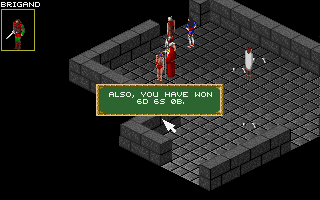

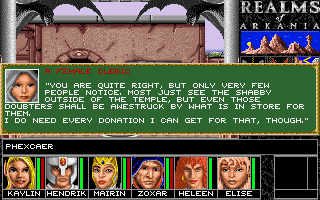
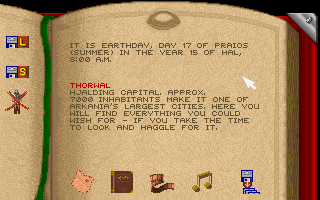
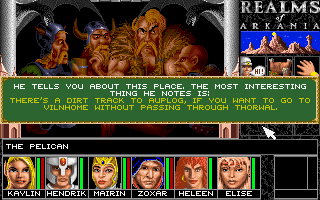
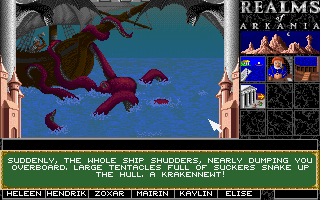
Main Quest
So, since we covered all main topic, let’s move to the main quest:

Much like the game, appear simple in the surface, but is more tricky that it looks, sure on the surface is about finding Hyggelik lost sword and challenge the Orc leader to a duel… as a premise is pretty simple, but it is always in your mind.
However, to do this you have to track down his descendants because Hyggelik died during an expedition or something, with the knowledge of the location of his tomb was only given to a handful of survivors of his expedition, and this guys passed the map to their descendants.
This means that you spend a good amount of time tracking this npcs around the map and talking to them. Each one might require a different approach, for some you might need to be polite, while for other you need to be harsh or even perform a quest. Once done, each will give you a map piece, there is a total of ten of them, however, you only need seven.
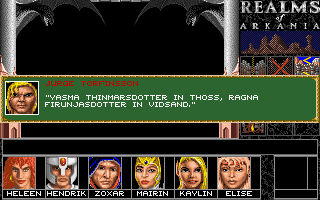
That said, here I feel the game might have a slight pace problem, due to the fact that while you might get general directions of npcs, finding them inside towns is another story, not the end of the world, keep in mind, as save one or two towns, which are quite big, the rest is not that large, but still going door to door is a bit annoying.
Also, each npc will point you to a list of other potential leads and their locations. There is no order, you can look for them in any way you want.
Thing is, you can sort of fail in some encounters, I did this early on, I got a dialogue wrong and missed a piece, but the game does feature a safety mechanism, there is a place where you can find a unicorn which will give you a random map piece, this isn’t a hundred percent reliable, but something that avoid you soft locking yourself. Another mechanism the game offer is a place around Hermit’s Lake where you find a device which tell you all the npcs which hold a map piece or might lead to one.
But the game does something at its very start that is kind funny and weird: you see, once you create your party, the main quest does not start, rather you need to keep going in taverns in Thorwal (the game initial city), hoping for a herald to show up, which then start the quest as your party goes to find the Hetman of Thorwal. Meaning that you can be wandering around with no clue and I have no idea if the herald even show up in other towns (in case you leave).
But once you got the main quest start and got enough map pieces, you can go for the game last part, which is about finding Hyggelik tomb and the location where the Orc army will show up (not in necessary order).
Hyggelik tomb is halfway in a route toward Phexcaer (I think any of them, the cluebook and walkthrough say Vilnhome, but I swear I find it other ways), while the Orc cave you might need to go is very off-road (in the most literal way), begin between Phexcaer and Skeletten, and if you look on the map you might notice there is no road. Instead, there is a exit point in each town that take you to this route, which by far is the most annoying, since halfway it features a spot where you can lose items and also is pretty huge, so ambushes and watching for supplies is a concern.
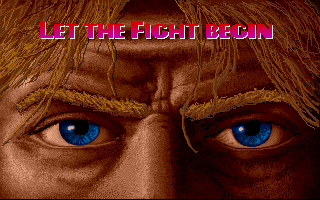
Once that is done, all you need going for route between Phexcaer and Hermit’s Lake and halfway you will come across the Orc army. Now, with sword in hand, all you need to do is challenge the Orc leader, by choosing a character to do the duel, is a curious battle. The Orc leader isn’t too hard, you likely win in a few rounds, but your whole party will be there in the sideline and the orcs too and what make it weird is that you can control the rest of the party, I don’t think you can interfere, as some dialogue suggests that the orc shaman does something before to stop this. But is keeping have to press the pass turn for all your party in the duel is strange and at least twice caused me to pass the turn for the duelist which was still fighting.
Once defeated, the Orc Shaman will say they will honor that they word and leave… And attack another town… With this the game comes to an end, sadly the Hetman of Thorwal will take the sword and give some ducats. But at least you are ready for the next game… well in theory… because while you can make a final save to use in the next game, you will need to deal with the infamous “kid face bug”.


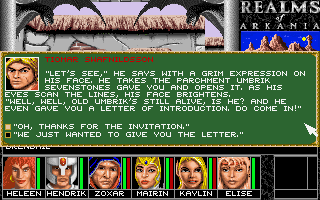
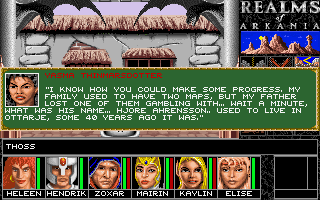

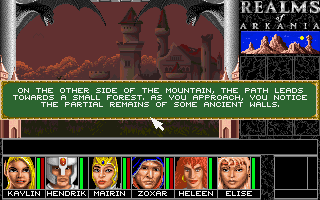
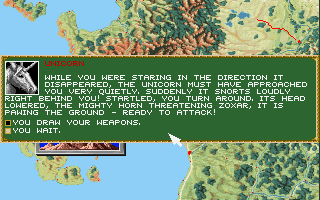
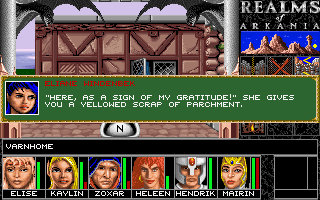
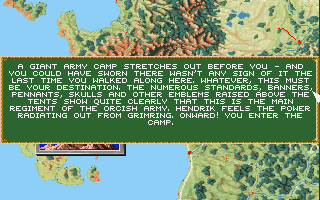

Dealing with the “Kid Face Bug”
There is a known bug where when you take your save from Blades of Destiny to Star Trail, the character portraits will be changed to kids, for reasons no one knows. However, what is known is the fix!
So to quote a user (johntuck77) of the gog forum:
1)Download the following Hex Editor you can find it at this website http://www.softpedia.com/progDownload/tiny-hexer-Download-35737.html
2) Install the editor and open your save game which you imported into ROA2. BEFORE YOU CHANGE ANYTHING MAKE A BACKUP COPY OF YOUR SAVEGAME.
3) You can either find it manually or by pressing Ctrl+F and look for the word “CHAR”. It is usually located right before your characters name. Click the letter C of CHAR and make sure it is highlighted in the Hex editor as well.
4) Here comes the most important thing. Press Ctrl +G in the field type in +0xB7 this will take you about 5 lines further down from the word CHAR and you should see right where it lands or right next to it the number “10”
5) Replace the number 10 with 00 and save.
6) Repeat the previous steps for all your characters.
So here is what I did, first I picked up the save which you will make when the game ends, which most time it will be in /gog galaxy/games/realms of arkania 1. The file is a .gam, in my case trueend3.gam
I pick up that first and throw it on /gog galaxy/games/realms of arkania 2/game. But that isn´t the actual place, instead, at least for me, I had to go in /gog galaxy/games/Realms of Arkania 2/Cloud Saves/Games.
I need to do a couple of tries to get the process right, is easy to miss click something, so make backups, at least once I made a mistake and end with my magician character inventory full of arrows, and somehow he was taking a lot of damage out of nowhere. But I got it done.
Remake or Remaster or something in between.

While the actual remaster version of this game, or at least of the two games, exist, and it is a known disaster where developer likely did what they can, but maybe ending bite more that they can chow. I still wonder would be actually really possible to make a remaster or remake or something?
And even more, it is really needed? Because, to be fair, I think the game still highly playable, sure is a bit awkward reading the manual/club book, but in terms of a game aging is still a lot smoother that other cases.
But also I can see stuff which could be improved or add, extra art assets (such as textures and portraits, maybe sprites too), tooltips (ok, this one sort got added in the next game), some quest adjustments (due to some instafail states that can happen), however nothing of that is easy or cheap.
Now while playing this I got thinking a lot about the Bard’s Tale remaster, it is a good example of how it can be done, or maybe a particular way to get it done. There they could find a way to keep the game and add carefully quality of life elements, while also adding the option to play it as original it was possible.
I wonder if sometimes the issue with remakes/remasters, is that sometimes false necessity by maybe both developers and audience, can cause them to try to fix the wrong problems, or something which isn’t a problem at all. In part because it is easy to look at something not as a style, model or type, but something that should be thrown away in the vague name of “progress” and this can lead to a lot of problems down the road.
Dimensions

The problem more evidently in the Blade of Destiny entry, is the simple representation of space, much like I said above, what made it possible, this allows it to be both large and small at the same time.
Not only this, the actual game content is spread out for its current size, if you ever change it, now you have a new problem: either you add more content, which itself is not a simple problem, or you will end up with empty spaces.
Again, let’s refresh something: The game feature an over world map with 52 towns and 16 dungeons. Later games would reduce scope, but still relatively large in their own right. In fact, by the time of the third game, even the movement and type of 3D would move toward a more modern style. But the point is that Blade of Destiny, might be harder to remake even than the sequels.
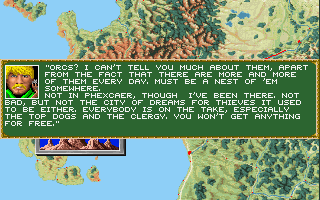
Keep in mind, I am talking about just the dungeons and towns, not the actual space between, imagine trying to make it like a modern open world game, it would be such a Herculean task to the point of being, well, pointless (also would mean need to remake the entire survival aspect of the game, add who knows makings tons and tons of content).
One solution, might be cut parts, but I dislike this, again in this particular case, I feel part of what make the first game what is it, was this ambition of making the setting “alive”, even more, cutting stuff might appear simple, but isn’t, as might mean rebalance a lot of stuff, from routes (specially the ships), encounters rates, events and so on.
Rule Set
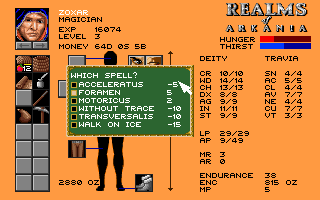
An easy temptation lies here, and again this is complicated, sure it is easily to look at the rather direct adaptation of the old rule set as something that could be removed, but I think this is a huge mistake. Because much what make Realms of Arkania begin what it is and what give it identity, and what it allows to stand out, is the system, and again it wasn’t just any system, but rather one of the most famous tabletop rpgs in Germany. Without, the game simple risk too much lose what it is and becoming sort generic and bland, even if in the surface looked streamlined.
But that not all, question remain, replace with what? Because while the tabletop setting got new editions, so one can easily imagine an update, that still not a easy thing, nor it will make the game more streamline. And again mean remake and rebalance so much stuff. Also let´s not forget, the game does even come with to settings, Advanced or Novice, in the later the game decided a lot of the character creation and development for you.
Now, with a more careful approach, it is possible to see things that could be improved, from tooltips, giving many of the game skills and spell actual uses, combat feedback and so on. How knows, maybe even add some new archetypes…
Plot
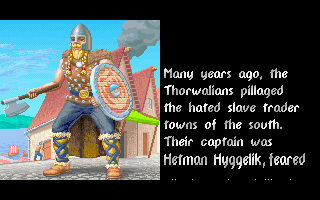
To begin a rather straightforward, there is much or maybe anything that might need a change in the text of the plot itself, while minor adjustment might be made, still minor stuff.
Look, a simple premises isn’t a bad thing nor a sign of weak writing, I sometimes feel there is this notion of everything has to be overcomplicated, but not in the way of making it interesting to the audience, but rather for it own sake, which can lead to obfuscation. A simple premises can be a strong hook, which keep the audience knowing the stake all the time, while also it can unfold, but still easy to summarize.
But like I said way above, there is some structure or clarity that maybe could be added, from the failstates that can happen when looking for the map pieces, I don’t mean remove them, but rather give slightly more clear instruction.
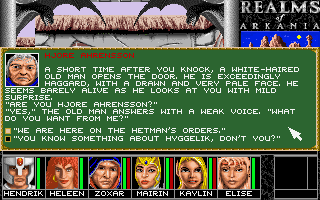
Take one npc, which require you to be hard more direct and harsh, otherwise he just gives you some directions and then ignore you in favor of keeping partying. Or another which you have a single try of getting the map from him, since once you visit him, a few days later he dies.
I don’t think this part should be removed, but maybe more clear direction or suggestions could help, because those npc having behaviors of their own make the story more dynamic.
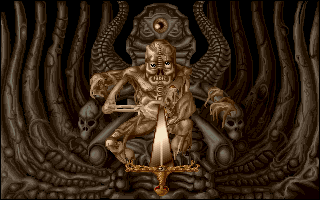
Now I can see some part of the plot which could be expanded a bit, such what exactly happened to Hyggelik, sure the intro tell about his failed expedition and ambush… but we find him in a tomb inside a ruined castle, which have some cursed gold coins that made him and his companions undead… I feel there is an easy to miss connection somewhere*, like he died during the ambush and his companions find or made a tomb? Or he made it and then died later? Where the curse gold coins come from? It was from his expedition in the south?
Note: Part of his confusion might be due the intro being made very early and the artists have not clear idea of the setting, as you can notice the orcs in the intro and the game does not match up at all.
So, about Drakensang…
Know what? There exist an actual, well at least for the time, modern version of a crpg based on the same setting and updated version ruleset: Drakensang and its sort sequels or prequels (I don’t remember), Drakensang: Phileasson´s Secret and Drakensang: River of Time.
While I have all of them, I only played and finish, the original Drakensang, and it is sort of crpg in the style of Neverwinter Nights 1/2 and maybe Dragon Age: Origins, but with the said campaign background and ruleset of Dark Eye. Unlikely in Realms of Arknia, here you only create a main character and add some npcs to your party (following the trend set before), also keep in mind it is a game with lots of ambition, but not the same levels of resources, so some edges can be rough.
Overall is Drakensang is a pretty good game, the ruleset is very different and it implementation a bit clunky (specially the wounding system), the plot however I feel is a bit too long and can be at times way too confusing, to the point you’re likely going from point to the other with little idea of what is going on, and things take a long time to happen, meaning that sometimes character and plot either can get introduced way too late or get buried.
Despite this, Drakensang is a good game if you want something in the style of Neverwinter Nights 1/2 or Dragon Age Origins, that uses a direct adaptation of the ruleset.
What to Except
So, I solved the "kid bug face" problem, got my save, so yeah, I will delve in Star Trail next, might not be in the next days, but it will happen.
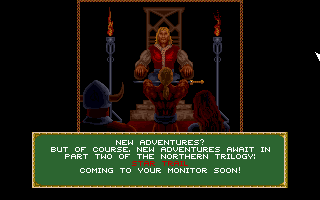
Log in to comment